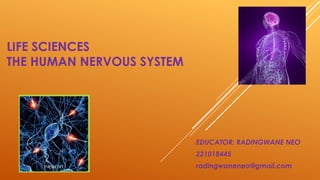
Nervous System Anatomy
- 1. LIFE SCIENCES THE HUMAN NERVOUS SYSTEM EDUCATOR: RADINGWANE NEO 221018445 radingwaneneo@gmail.com
- 2. THE CNS AND THE PNS HUMAN BRAIN ANATOMY DEVISIONS OF THE CENTRAL NERVOUS SYSTEM
- 3. There are two coordinating systems in humans: • Nervous system and • Endocrine system • The need for a nervous system in humans: The nervous system detects stimuli (changes in the environment) and allows for the body to react to these changes. • Stimuli can be external and internal. • The nervous system coordinates the various activities of the body e.g. walking, hearing etc
- 4. The human nervous system: The human nervous system is subdivided into two main sections i.e. Central nervous system – consisting of the brain and spinal cord Peripheral nervous system – consisting of nerves that conduct impulses to and from the brain and spinal cord. It includes 12 pairs of cranial nerves and 31 pairs of spinal nerves. The Central nervous system: The central nervous system consists of the brain and spinal cord (William Banaag, 2009). The brain is enclosed by the skull and the spinal cord by the vertebral column Both the brain and spinal cord are enclosed by the meninges.
- 5. THE BRAIN "The human brain starts working the moment you are born and never stops until you stand up to speak in public." — George Jessel.
- 6. THE SPINAL CORD: • THE SPINAL CORD CONSISTS OF: A CENTRAL CANAL THAT IS FILLED WITH CEREBROSPINAL FLUID • GREY MATTER AND WHITE MATTER Spinal nerves arise from both sides of the spinal cord. Each spinal nerve has a dorsal root and a ventral root. The dorsal root consists of sensory neurons and the ventral root consists of motor neurons.
- 7. FUNCTIONS OF THE SPINAL CORD: • PROVIDES A PATHWAY FOR NERVE IMPULSES TO AND FROM THE BRAIN. • THE SPINAL CORD SERVES AS A CENTRE FOR REFLEX ACTIONS.
- 8. • The peripheral nervous system includes all the nervous tissue situated outside the central nervous system i.e. 12 pairs of cranial nerves and 31 pairs of spinal nerves (Hari Sharan, 2021). • It consists of sensory nerves and motor nerves. • The motor nerves are subdivided into the somatic nervous system and the autonomic nervous system (Dr Ashok Dhaka Bishnoi, 2015). • The somatic nervous system conducts nerve impulses from the central nervous system to the voluntary muscles and controls voluntary actions e.g. running etc. • The autonomic nervous system conducts nerve impulses from the central nervous system to the involuntary muscles and glands and controls involuntary actions e.g. sneezing, blinking of eyes etc. Functions of the peripheral nervous system: • Conduct impulses from the receptors to the central nervous system. • Conduct impulses from the central nervous system to the effectors. THE PERIPHERAL SYSTEM
- 9. Location and functions of the autonomic nervous system (sympathetic and parasympathetic sections): • The autonomic nervous system has two subdivisions i.e. the sympathetic and the parasympathetic divisions (Kemberly Lee, 2019). • The sympathetic division prepares the body for an emergency. • The parasympathetic division allows the body to return to normal. Sympathetic division Increases heart rate Dilates pupils Increases blood pressure Parasympathetic division Decreases heart rate Constricts pupils Decreases blood pressure
- 10. Structure and functioning of a nerve: • Nervous tissue consists of millions of nerve cells called neurons. • A neuron has a cell body consisting of cytoplasm and a nucleus. • The cytoplasm contains granules, the Nissl - granules, which are rich in RNA and are involved in protein synthesis. • Two types of outgrowths extend from the cell body i.e. dendrites and axons. • Dendrites conduct nerve impulses to the cell body. • Axons conduct nerve impulses away from the cell body. • Most of the nerve tissue outside the central nervous system are enclosed by a myelin sheath which is formed by cells, called the Schwann cells. The myelin sheath insulates nerve fibres and accelerates the transmission of nerve impulses, (Subramani Parasuraman, 2019).
- 11. STRUCTURE OF A MOTOR NEURON
- 12. STRUCTURE OF A SENSORY NEURON.
- 13. THE SIMPLE REFLEX ARC: • Reflex action: a quick, automatic response to a stimulus and does not involve the brain. Protects the body from harm e.g. blinking of eyes, coughing etc. • Reflex arc: the pathway along which nerve impulses are conducted from a receptor to an effector to bring about a reflex action.
- 14. THE PATH OF A REFLEX ARC: Significance of a reflex action: • A reflex action is rapid to protect the body from injury
- 15. A synapse: • A synapse is the functional connection between the axon of one neuron, and the dendrites of another neuron. Significance of a synapse: • Synapses ensure that impulses can only move in one direction. • Impulses can be transmitted to more than one neuron at a synapse. • A synapse determines which impulse will be transmitted to the next neuron. Disorders of the Central Nervous System: You need to know the causes and symptoms of the following disorders i.e. Alzheimer's disease and multiple sclerosis. • Alzheimer’s disease – occurs when healthy neurons become less and less efficient. Symptoms include memory loss and confusion. • Multiple sclerosis – occurs when the body’s own immune system destroys the myelin sheaths of neurons. (Remember the myelin sheath insulates the nerve fibres and accelerates the transmission of nerve impulses). Symptoms include loss of muscle control and coordination in all parts of the body.